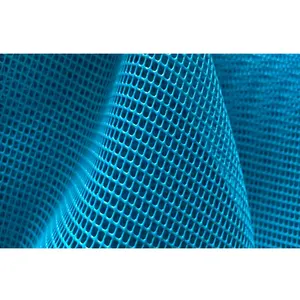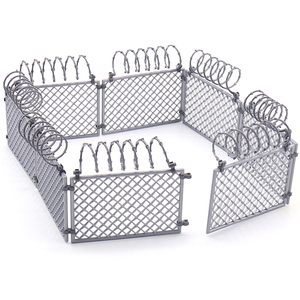(40 products available)


















































































































































































































Army fence mesh is a tough and strong material used to make fences for military purposes. These fences keep people safe, protect areas, and control who can come in or out. They are made of strong wire or mesh material that can withstand bad weather and provide a high level of security. There are different kinds of army fence mesh to choose from, such as welded wire fences, chain link fences, barbed wire fences, concertina wire fences, and blast protection fences. Each kind has its own benefits and is used in different situations depending on what is needed for safety and protection.
Welded wire mesh fence
This type of fence is made by welding thin wires together to form a strong mesh. It's commonly used for military bases, training areas, and other secure sites where a durable and low-maintenance barrier is needed. The welded wire mesh provides visibility while deterring unauthorized access and protecting the perimeter.
Chain link fence with concertina wire
A chain link fence with concertina wire is a type of security fence that combines a chain link mesh fence with concertina wire. This fence is typically used in areas that require a high level of security, such as military bases, prisons, or government buildings. The chain link mesh provides a strong barrier against unauthorized entry, while the concertina wire adds an extra layer of protection against climbing over the fence.
Barbed wire fence
Barbed wire fences are created by twisting thin wires together, forming sharp barbs along the wire. These fences are often used for military purposes, borders, farms, ranches, etc. Barbed wire fences are tough, hard to break, and cheap to make, making them a good option when a strong fence is needed that doesn't cost a lot.
Concertina wire fence
Concertina wire fences are made from coiled barbed wire and are used for security. These fences are often put on top of other fences to make them harder to climb over. Concertina wire fences are used in places like military bases and prisons where keeping people safe is important.
Blast protection fence
These fences are made to protect against explosions and blasts. They are used in areas where there may be risks of explosions, such as places that handle dangerous materials. Blast protection fences help absorb and redirect the force from an explosion, keeping people and things safe from harm.
Concertina Wire Fencing
This design incorporates concertina razor wire along with other types of fencing. The concertina wire serves as a top barrier for fences to protect against intruders.
Chain Link Fencing
Army chain link fences are made from heavy gauge steel links woven into a mesh pattern. These links vary in sizes depending on specific applications. Smaller mesh sizes are used for security around military bases, while larger openings may be used for less critical areas. The links are galvanized for rust protection and coated with black vinyl for an unobtrusive appearance.
Modular Panel Fencing
Modular panels are pre-fabricated in a factory and transported to site for assembly. Each panel consists of welded wire mesh framed within steel rails. Panels are mounted onto fence posts that are driven into the ground. Modular panel fencing can be installed much quicker than other types, making it suitable for temporary military sites.
Barbed Wire Fencing
Barbed wire fences utilize wires twisted together with sharp barbs spaced along them. These barbs act as physical deterrents to unauthorized persons. Barbed spacing and gauge thickness are chosen based on the level of security required for different army locations.
Woven Wire Mesh Fencing
This type of mesh is made by weaving together horizontal and vertical wires into patterns. Steel wires of various diameters can be used depending on strength needs. The woven design allows flexibility while withstanding impacts, making it ideal for protecting military areas from wildlife and intruders.
Razor Wire Fencing
Razor wire consists of thin strips of steel formed into sharp, crisscrossed patterns. Like concertina wire, razor wire can be added to the top of other fences or used standalone barriers. The closely spaced blades pose a severe risk to anyone attempting to cross the perimeter.
Riot Control Fencing
Army riot control mesh is designed to withstand high impact from crowds. These fences may use reinforced welded wire or modular panel systems that are anchored very deeply into the ground. Fences can be quickly deployed and removed during civil unrest situations.
Army fence mesh has multiple uses in different industries. These scenarios depict the importance of these screens in providing security and safety.
Construction
Construction sites use army mesh fences to protect the area and control access. They limit the site and reduce the risk of tools and equipment being stolen. These screens also stop materials from falling off the site and causing harm. The sturdy mesh can contain debris and is vital for building safety.
Mining
The mining industry uses these fences to make steep slopes and prevent rock slides. They stop loose rocks from falling into work areas or public places. The mesh also make secure zones for blasting operations by limiting the blast radius and protecting people nearby.
Agriculture
Farmers use army screens to protect crops from animals. Livestock and wild animals can't reach the plants when these fences surround them. They also shield gardens from birds and other creatures that may eat the fruits and vegetables. Farmers can use these fences to make a controlled environment for young plants. They keep out pests and help plants grow in a safe space.
Environmental Protection
In erosion control projects, engineers use mesh fences to hold soil in place on slopes. They reduce the risk of soil wash away during rain. Wildlife protection is another use of army mesh. They create barriers to keep animals off roads to reduce vehicle collisions. This mesh also makes tunnels under roads so animals can cross safely.
Sports and Recreation
Sports facilities use army mesh fences to protect spectators. These screens prevent balls and other objects from leaving the play area and hitting fans. They also define the game areas and increase the visibility of the boundaries. Motor racetracks use mesh fences to stop cars from leaving the track and to reduce crash impacts. They can absorb the shock and redirect the vehicle along the track.
Purpose and Location:
When choosing army fence mesh, it's important to consider its purpose and location. Is it for securing a military base, creating a training area, or protecting equipment? Also, where is it being placed? In a forest, desert, or urban area? This will affect the kind of fence mesh needed. For example, a fence for a desert base needs to withstand very hot temperatures and sandstorms, while one for a forest area needs to allow wind but not block trees.
Material and Durability:
Army fence mesh is made from tough materials like galvanized steel wire, stainless steel, or PVC-coated fabric. Galvanized steel is good for wet places because it doesn't rust easily. Stainless steel can handle very high or low temperatures. PVC-coated mesh is used where people walk a lot because it stays clean and doesn't get holes in it fast.
Visibility and Camouflage:
Sometimes the fence mesh needs to be seen, like around dangerous things, so people use bright colors. Other times, it needs to blend in with nature. Army fence mesh can be made to look like green bushes or brown dirt, or even broken up patterns to hide what it surrounds better.
Size and Flexibility:
The openings in the mesh and how much it bends are also important. Smaller holes keep out little animals and debris better but may cost more. Less flexible mesh fences are simpler to put up and stay in place longer.
Installation and Maintenance:
It's good to pick a fence mesh that is simple to install and does not need a lot of care. This will save money and time. Some fences can be put up and forgotten about for a long time without needing any repairs.
Budget and Regulations:
Finally, consider the budget. How much money can be spent? Also, are there any rules that must be followed? Sometimes, there are special requirements for fences used by the army or in certain security areas.
Q1: What is an army fence mesh used for?
A1: An army fence mesh is used for security, privacy, and protection in military installations.
Q2: What are the benefits of using an army fence mesh?
A2: The benefits of using army fencing mesh include enhanced security, reduced wind damage, and improved privacy.
Q3: How can one install an army fence mesh?
A3: One can install an army fence mesh by preparing the site, installing the posts, attaching the mesh, securing the connections, and trimming any excess mesh.
Q4: What maintenance does an army fence mesh require?
A4: The maintenance that an army fence mesh requires includes regular inspection, cleaning, tightening fasteners, and repairing damages.
Q5: What types of army fence mesh are there?
A5: There are welded wire mesh, woven wire mesh, and barbed wire mesh.